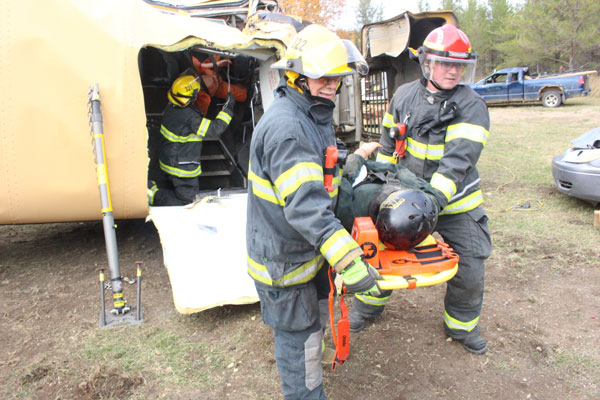
Buckland Fire and Rescue took part in a weekend of training at their fire hall near Prince Albert over the weekend. Trans-Care Rescue facilitated the training and on Saturday the firefighters took part in a simulated rescue from a school bus.
According to deputy fire chief Chris Doucette, Highway 3 sees traffic from school buses, commercial buses, tractor-trailer units and other heavy vehicles.
“Part of our continuing training program is we want to make sure our members are trained in heavy rescue and have the tools and the training they need in the event that we get called to one of those situations,” Doucette said.
They began on Friday night and continued all day Saturday and Sunday.
Bill McCombs of Trans-Care Rescue Ltd., based out of Langham, explained that the company does training all over Western Canada and in other countries. They discussed commercial buses but worked with a school bus in the practice on Saturday.
“Across Saskatchewan there is a roughly 20 school bus accident a year, that is a lot,” McCombs said.
There are some minor ones but there are also major ones. For example, a gravel road can cause a rollover and buses can catch the shoulder and cause accidents.
“What we do the program for is to teach these departments how to stabilize. The structure on these things is so much different than a car. They are very heavy, they are very strong. They realized that this morning when we were using a big backhoe to crush it,” he said.
The school bus had six mannequin passengers and a vehicle with a passenger was crushed under the bus. McCombs explained that the bus is difficult to take apart. With the potential for passenger injuries, overall, it can be a tougher scenario for rescue.
“On top of that there is more injuries because when it rolls over there is nothing to stop them from flying. If you have got little kids on there especially if you look at the size of the bus how far can they be thrown around and on to each other. They all end up in a pile on the bottom. Basically what happens here is they have got to go in and it is like a game of Jenga so the arms and legs will be everywhere.”
Injured bus passengers can also hurt each other as they struggle to get free, McCombs said.
“It becomes very complicated.”
He said that firefighters in a situation like this would have to stabilize the bus first in order to rescue the person trapped in the car. Strong struts are used to hold the bus in place as firefighters work to raise it and cut it open.
“W have got to lift the bus a little, stabilize the bus and then they are going to work their way into the bus to make a big opening,” he said.
The amount of passengers on the bus in the weekend’s practice scenario was similar to a bus traveling the highway after making a few drop-offs after school.
Once they entered the bus, the firefighters would cut the seats out.
“It is totally different than a normal extrication,” McCombs said.
It took about 45 minutes for the firefighters to get the bus open.
“People have a tough time understanding because if their kid is on the bus that they want to get in and they want to do stuff they actually can’t. We have to keep them way back because they are a major hindrance to us,” McCombs said.
In a real scenario like the one on Saturday, the injured people would be taken to a civic center or fire hall with assistance from RCMP or City Police to be checked by paramedics. The injured would then be released to parents or guardians.
“It has got to very controlled because parents become very agitated, humans are humans,” McCombs said.
He said that buses are made safe and are strong vehicles.
“The only thing is it would be nice if they could put seatbelts on them. They are gradually working that way but there are all kinds of issues with that. We will see what happens down the road. Commercial buses after 2019 all have to have seatbelts, but not school buses,” McCombs said.
The training couldn’t have been done without contributions from people around the area.
“Buckland Fire and Rescue wants to thank the Saskatchewan Rivers School Division for donating the school bus for our training event today,” Doucette said.
He also thanked local businesses and SGI who provided vehicles, lumber and other supplies for the weekend’s training.

